How to grow pansies from seed
Author: Graham Rice
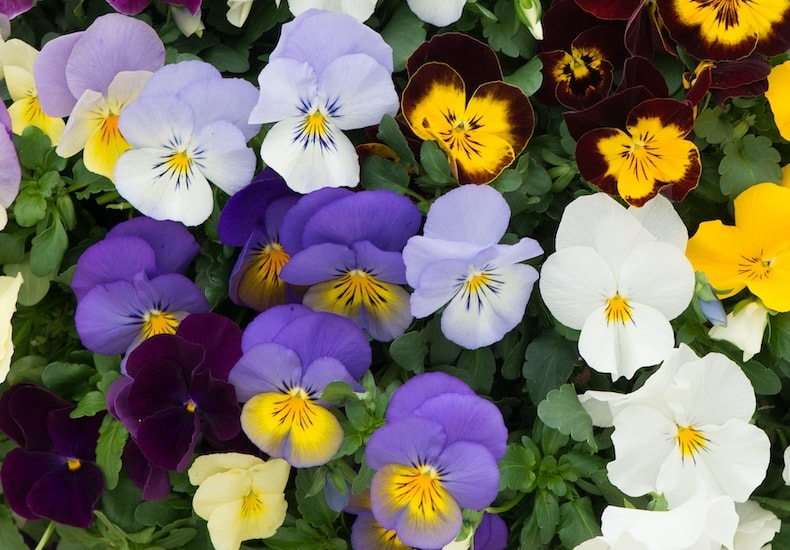
Pansies are available in a wide range of colours
Image: Pansy 'Trailing Mix' from Thompson & Morgan
In this article, horticultural expert Graham Rice examines one of the UK’s most popular bedding and container plants - the pansy. Whether you want to fill your garden with cheerful blooms in spring or choose to grow hardy varieties through the autumn and winter, here’s how to raise your plants from seed and get them off to a flying start.
Browse our full range of perennial and biennial flower seeds here.
What exactly is a pansy?
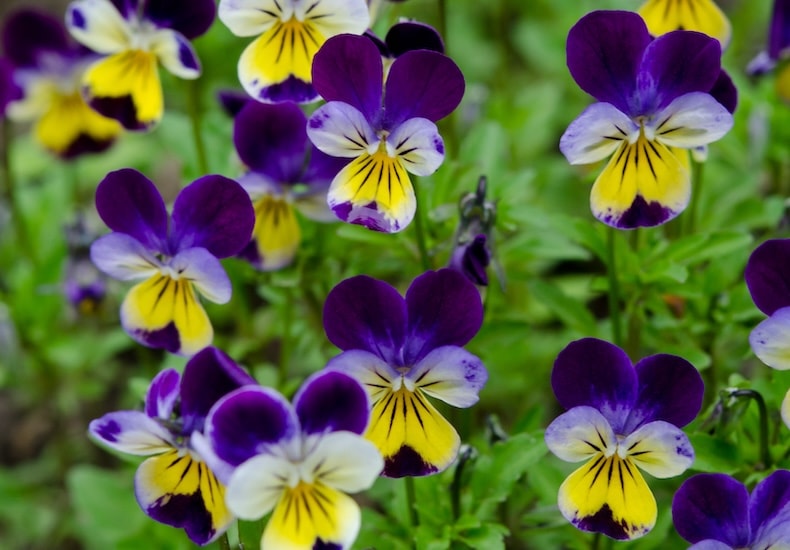
Viola tricolor grows to just 15cm high and has a long flowering season
Image: Viola tricolor seeds (Heartsease) from Thompson & Morgan
To many people, the definition of a pansy isn’t a simple question as pansies are often confused with violas and violettas. In fact it's quite simple. Pansies are derived from two parents: our native wild heartsease (Viola tricolor) and V. lutea.
The wild heartsease Viola tricolor subsp. tricolor is a straggly plant, usually an annual, although in undisturbed situations it may persist for a couple of years. It grows as a weed of cultivation and on waste ground and sometimes also in short-cropped grassland areas. It's far more common on acid and neutral soil and in limy conditions. The flowers are variable and are usually bluish-violet but with varying degrees of yellow on the lower petal. The flowers are very rarely without at least some blue.
The other parent of the garden pansy is the mountain pansy, V. lutea, which occurs in many forms all over Europe. Some authorities maintain that the form used as a breeding parent is subsp. sudetiana which grows in the mountains of central Europe. Others say that it was the form which grows in the Pentland Hills in southern Scotland which was used.
Unlike the heartsease, V. lutea is a creeping perennial plant with noticeably larger flowers. About the only constant feature of its flowers is that the base of the lower petal is always yellow. The flower may be entirely yellow or yellow combined with blue-violet or reddish-violet or both. This plant contributes the shorter, more tufted habit, reddish colouring, a tendency to pronounced whiskering and valuable variability.
The crossing of these two plants results in the garden pansy, V. x wittrockiana and the plants tend to be annuals, biennials or short-lived perennials which become straggly in their second year.
(Just for the record, violas are derived from crossing the garden pansy with other species, in particular V. cornuta, while violettas are basically dwarf forms of violas with no whiskers and a noticeable scent. Both are good perennials, most have a neat, compact habit.)
How the modern garden pansy emerged
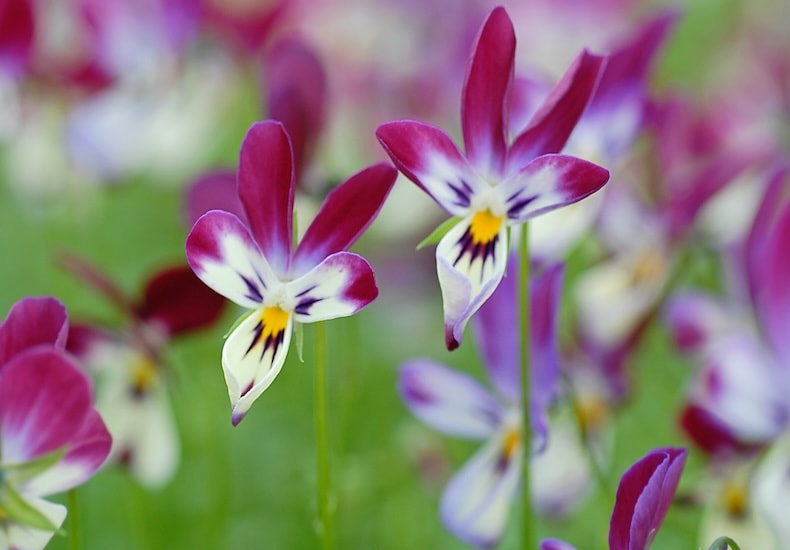
These unusual shaped flowers are also scented
Image: Viola hybrida 'Bunny Ears' (Viola x wittrockiana) from Thompson & Morgan
Development of the heartsease began in the early years of the nineteenth century with large flowers and especially attractive colour combinations being selected. Although basically annual plants, like a number of other annuals, they could also be increased from cuttings and this was the way in which selected forms were perpetuated.
It wasn’t until 1859 that James Grieve, who gave his name to the well-known apple, crossed the selected forms of heartsease with V. lutea. From then on, developments proceeded rapidly, both for bedding and as a cut flower for shows. The florist's varieties are very much a minority interest these days and, for most people, it's seed raised varieties which immediately spring to mind.
By 1900 the T&M seed catalogue was listing 20 varieties, including mixtures of seed saved from the best show varieties - which should have produced some interesting though unpredictable results. Even at this early stage a 'black' pansy ('fine dark purple variety, almost black') called 'Faust' was listed.
Twenty-four varieties were listed in 1954, again including seed from show varieties plus 'King of the Blacks' and a number such as 'Roggli Giants' and 'Coronation Gold' which were still listed in 1991.
Seed of show varieties had vanished by the time the 1991 catalogue from T&M was issued but it listed 42 varieties in all, including an improved version of 'King of the Blacks' called 'T&M's Black Pansy'.
Pansies for summer
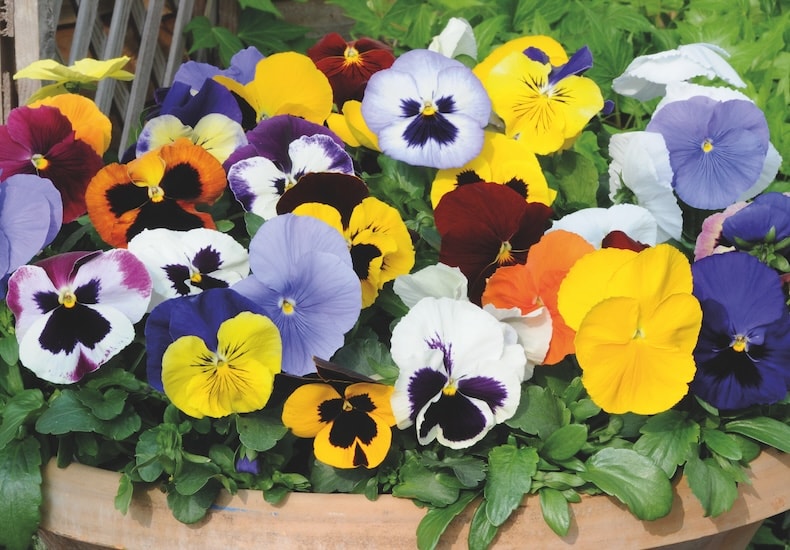
Available as garden ready plants, this 'Summertime Mix' is a great way to fill containers
Image: Pansy Summertime Mix (Garden Ready) from Thompson & Morgan
For many years, pansies were sown in summer for flowering in the spring. The first change was a tendency for them to be sown in the spring and grown as summer bedding plants. But in recent years there has also been a trend to growing them for winter flowering outdoors.
With such a vast array of varieties already grown as summer flowers and so few suitable for spring, it seems perverse to attempt to convert one of the very best spring flowers into a summer bedder.
And it must be said that, while all pansies will provide a fine show in spring from a sowing the previous year, there are many which will not thrive in the drier, hotter summer conditions. So why bother? Why not simply grow them for spring when they can be relied on to perform well?
But if you must grow summer pansies, the 'Imperial' series with their very large flowers in some stunning colour combinations are the ones to go for.
Pansies for winter
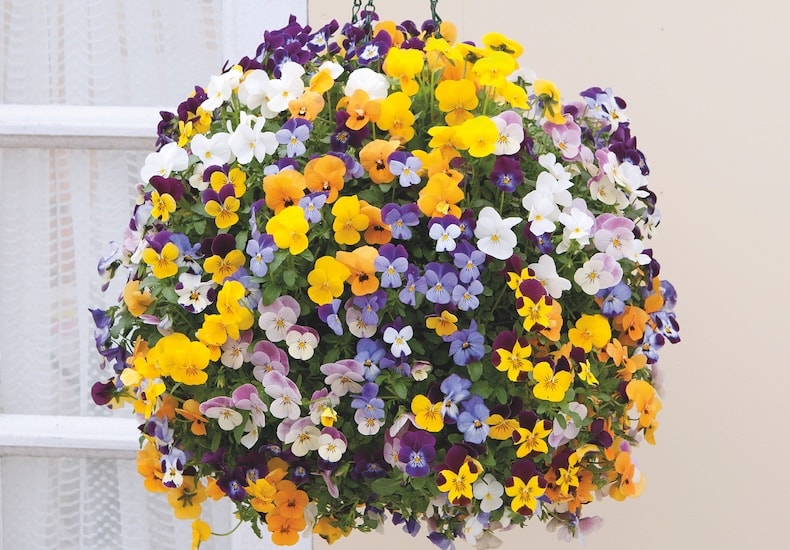
A hanging basket filled with Viola (Ice Babies) 'Teardrops' brightens up the winter months
Image: Viola (Ice Babies) 'Teardrops' Pre-Planted Hanging Basket from Thompson & Morgan
Winter-flowering pansies have received a great deal of publicity in recent years, but there have been varieties of this sort listed for many years. 'Celestial Queen' was the name in vogue in the late 1950s. In the 1970s and 1980s the names 'Winter Flowered Mixed' and 'Hiemalis' crop up in more than one catalogue. Generally these were all varieties which produced a few flowers in the autumn, a few flowers in mild spells in winter then started their main display early in the spring, though 'Hiemalis' was more genuinely winter-flowering but with small flowers.
From 1979 the massive promotion of the 'Universal' pansies as a genuine winter flowering variety increased people's awareness of the idea and posters showing them flowering in the snow fostered the idea that they really did flower all winter. This was something of an illusion. They tended to provide a good flush of flowers in the autumn but only a few during the winter. Some colours performed better than others, and there was a great deal of variation in the habit of the plants, some being very straggly.
In some trials where 'Universal' pansies were not entered, varieties like 'Reveille' were seen to do well and many people began to wonder if the very effective promotion of the 'Universals' rather over-emphasised their qualities (stronger words were often used!)
Other winter varieties soon began to appear but it wasn't until the 1990s at Springfield Gardens at Spalding in Lincolnshire that a comprehensive trial of winter pansies was organised. The plants were assessed on December 5 1990 and then on March 20 and April 16 1991. The head gardener at Springfields reported that few flowers were produced in the winter months.
Marks were awarded for 'flower power', colour uniformity, mixture balance, plant habit and general health and winners were announced for the best mixture and the best varieties in 16 separate colours. The winner for the best mixture was 'Favourite', a French variety which also did well in several of the separate colour categories.
The full results were as follows:
- Mixed: 'Favourite Mixed'
- Pure white: 'Favourite White'
- White with blotch: 'Ice Queen Blue with Blotch'
- Blue and white: 'Ice Queen Blue with White Flag'
- Light blue: 'Reveille Mid Blue'
- Dark blue: 'Challenge Deep Blue'
- Blue with blotch: 'Universal Blue Blotch'
- Purple and violets: 'Universal Violet'
- Reds and red blotches: 'Favourite Red Blotch'
- Roses and rose blotches: 'Favourite Rose Blotch'
- Pink shades: 'Ultima Pink Shades'
- Redwings/red on yellows: 'Rock Yellow and Red'
- Oranges and apricots: 'Spring Fiesta Orange'
- Mixed red shades: 'Ultima Love'
- Primrose: 'Universal Primrose'
- Yellow with blotch: 'Universal Yellow Blotch'
- Pure yellow: 'Favourite Yellow'
The most striking thing about this list of winners is not that the 'Universals' have failed to live up to their extravagant promotion, but that so few of the winners are even available to home gardeners.
How the colours of pansies have evolved
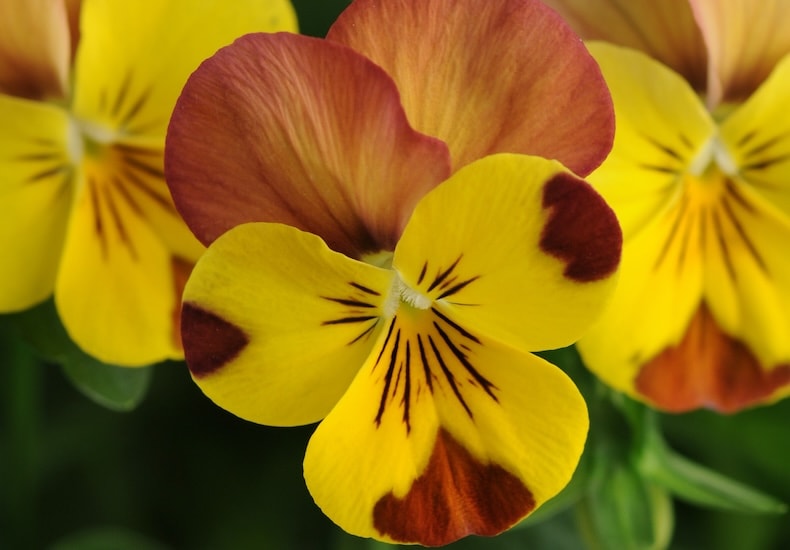
With exquisitely detailed faces, 'Sorbet Peach Melba' combines beautifully with spring bulbs
Image: Viola 'Sorbet Peach Melba' from Thompson & Morgan
The other main trend has been towards unusual colours and colour combinations and there has been quite an influx of these in recent years. They can be broken down into those in the familiar patterns but with unusual colours, and those in completely new patterns.
Varieties with red or pink blotches are very striking and those like 'Imperial Silver Princess' in white with a whiskered red blotch and 'Imperial Gold Princess' in deep yellow with a red blotch have become more widely grown. These F1 hybrids can be more expensive, and perhaps the most popular of this type is 'Love Duet' in shades of white, cream and palest pink with a pink blotch.
Pansies with a much more distinctive and more complicated face rather than a simple blotch have been introduced in recent years. 'Joker Light Blue' is the most distinctive; it has a tiny yellow eye at the centre of a dark blue, cat-faced blotch, this is surrounded by a white butterfly shape and then the whole surrounded by a band of pale blue. This F2 hybrid is rather variable and the F1 'Maxim Marina' is similar but more stable. 'Joker Viola Gold' is similar in purple and orange but 'Jolly Joker' is deep purple with a very large, rather variable orange blotch.
The other main group are those in which the flower is almost entirely dark with a pale rim to each petal. 'Rippling Waters' is deep purple with a narrow off-white border, while 'Brunig' is deep mahogany with a gold rim. These too can be variable, but at their best are very striking, and still available today.
One other that needs mentioning is 'Delft', a very unusual and striking combination. The lower three petals are creamy yellow with a little fine whiskering, while the upper two petals are blue with a creamy edge. Very choice!
Where to plant pansies in the garden
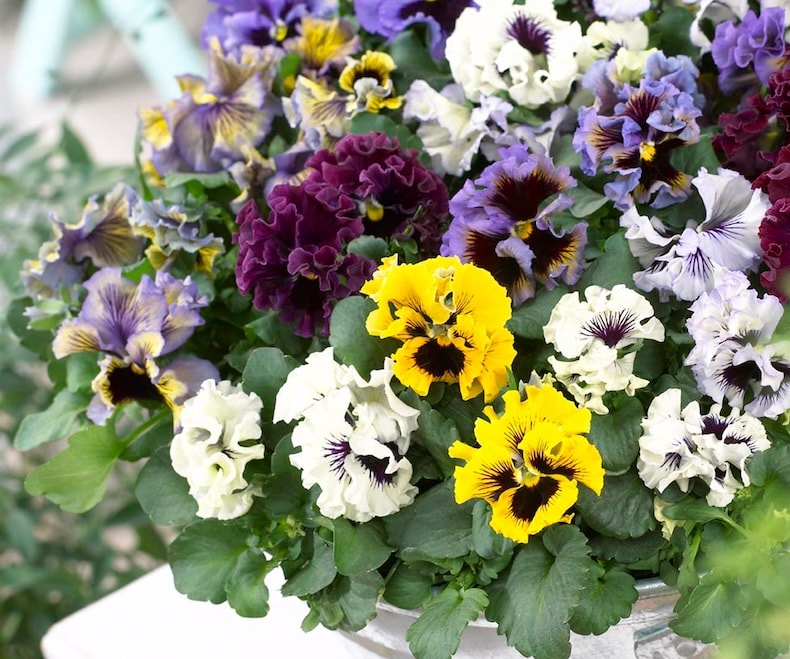
Wide, flat containers show pansies off to good advantage
Image: Pansy 'Frizzle Sizzle' Mixed from Thompson & Morgan
Pansies are ideal for a temporary spring display either in beds or containers. A hanging basket planted solely with pansies is very effective and they trail over the edge of window boxes without hanging down too far. Dwarf and medium-sized bulbs like the daintier daffodils, grape hyacinths and species tulips are ideal companions.
In larger containers they can be used as an edging to taller plants like wallflowers or tall forget-me-nots and the bulbs used can be a shade taller and more substantial.
But perhaps the best way to use pansies, especially those with the more interesting colour combinations, is on their own in a broad rather flat container. They can be displayed on the patio or near the door where you can see them and provide a long spell of intriguing colours.
In mixed borders, pansies fit in quite well. Few except the very brightest like the orange 'Padparadja' look out of place amongst perennials. They can either be slipped in wherever you feel the need of a little spring colour or you can leave spaces for small groups, which can be replaced with choice annuals for the summer.
When to sow pansy seeds
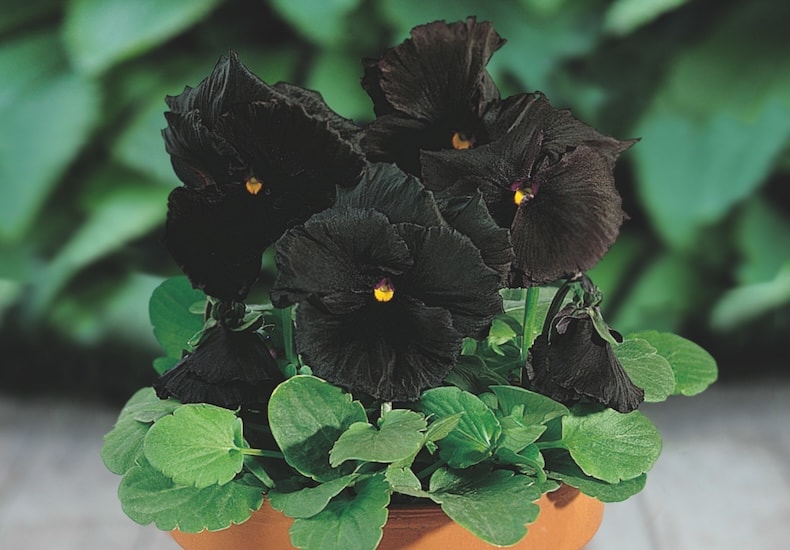
Pansy 'Black Moon' boasts velvety-black petals
Image: Pansy 'Black Moon' F1 Hybrid Seeds from Thompson & Morgan
Pansies are not difficult to raise from seed. For autumn planting to flower in spring, seed can be sown at any time from May to early July. A soil-less compost is suitable but should have extra perlite added if you suspect the drainage may be poor. Cover thinly with vermiculite and place in a temperature of 59-65F (15-18C) to germinate. High temperatures and fluctuating moisture levels are the most likely causes of failure.
Prick out the seedlings when they are large enough to handle using a similar compost. They can either go into trays, or I use 7cm square pots; early sowings may appreciate 9cm pots. The plants can grow on in a frame until September, when they will be ready for planting. For containers and for hanging baskets in particular, planting in early spring is often more successful. In this case a later sowing is suitable, August or September, and the seedlings should be pricked out into 9cm pots and grown through the winter in a cold frame before planting up in early March. They should only be covered in severe weather.
If you should wish to grow them for summer flowering, sow the seed in March and raise them like summer bedding.
Pansies suffer from very few problems. Aphids are the most common, and a regular spray with a suitable insecticide will see them off. Slugs can cause problems in wet seasons but perhaps the thing that causes the most disquiet is leaf spot. Brown or white spots occur on the foliage but a cure is difficult to achieve. Spraying with Dithane 945 or a similar fungicide will help stop further spread.
We hope we’ve answered all your pansy questions, but if not, please find more information and advice on bedding plants over at our hub page. Share your pansies with us using #YourTMGarden. We love to hear from you!
More about the author: Graham Rice was trained at Kew and is now a horticultural journalist and author. He is Editor of Growing from Seed and author of A Handbook of Annuals and Bedding Plants (Croom/Helm/Timber Press).
Source of article
Growing From Seed - Autumn 1991 Vol. 5 Number 4
© The Seed Raising Journal from Thompson & Morgan
Sign Up For Exclusive Special Offers




© 2024 Thompson & Morgan. All rights reserved. A division of Branded Garden Products Limited.
Sign up for exclusive offers!



